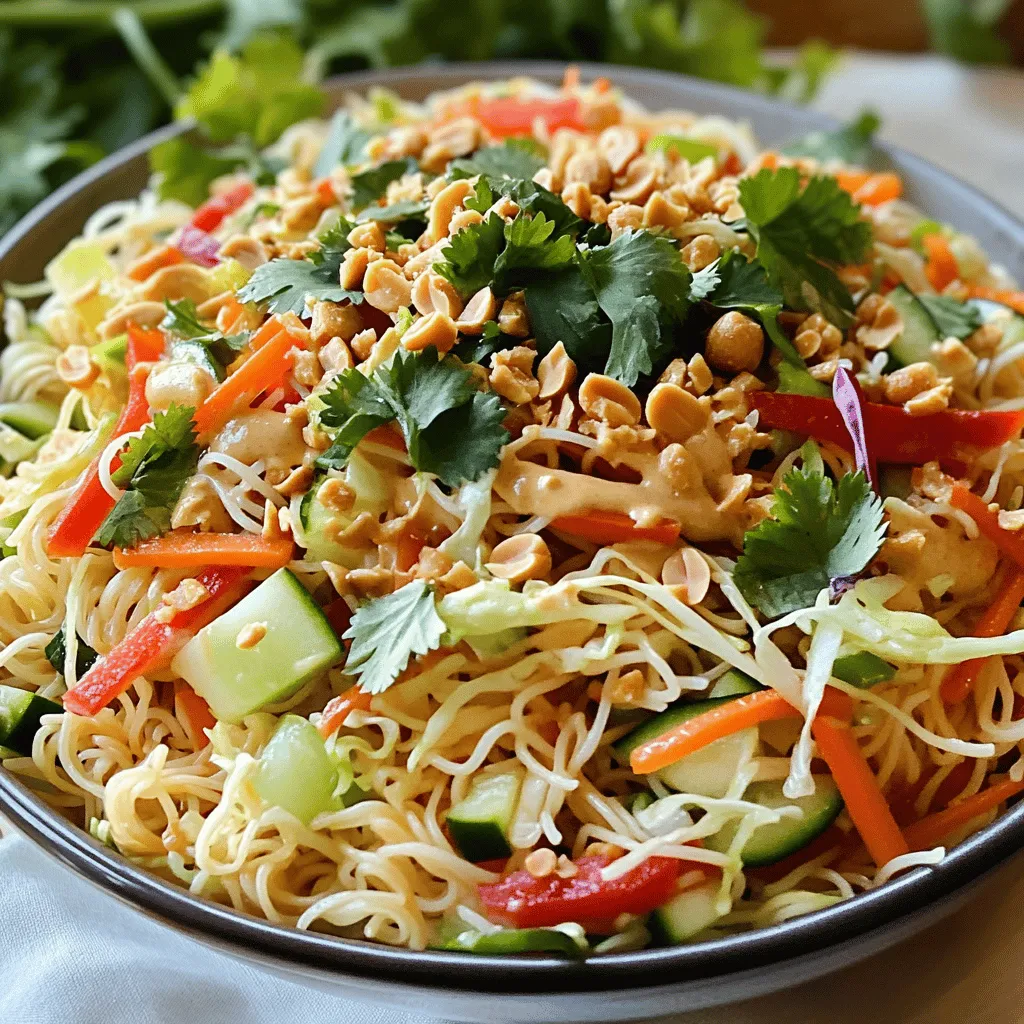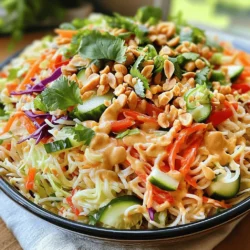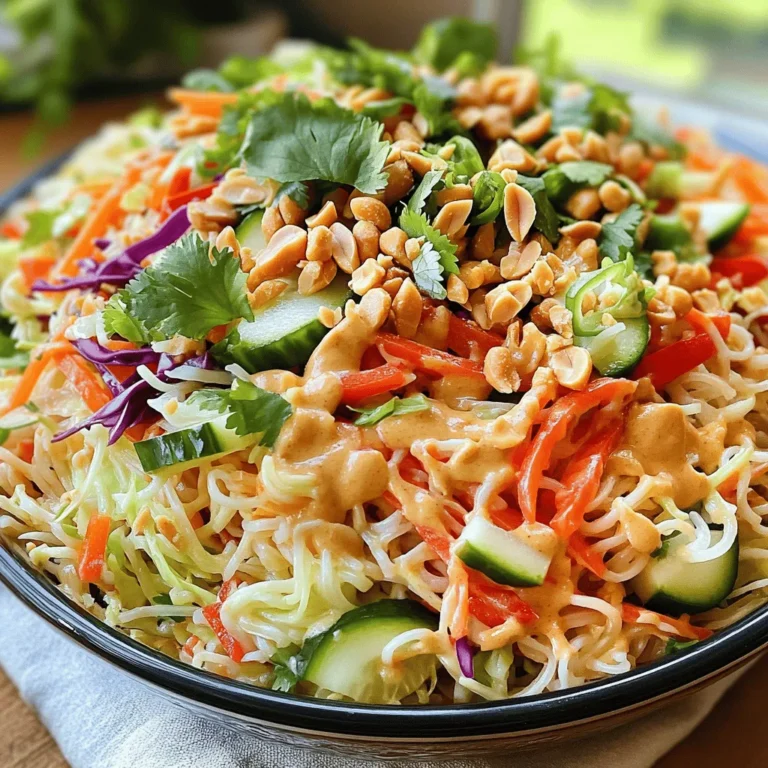Craving a dish that bursts with flavor and freshness? Thai Peanut Noodle Salad delivers just that! Packed with vibrant veggies, rich noodles, and a creamy peanut dressing, this salad is a winner for any meal. In this article, I’ll guide you through easy steps, ingredient benefits, and personal tips for making this delightful dish your own. Let’s dive into a world of taste and nutrition that’s simple to create!
Ingredients
Main Ingredients
To make the Thai Peanut Noodle Salad, you need these main items:
- 8 ounces rice noodles
- 1 cup shredded carrots
- 1 red bell pepper, thinly sliced
- 1 cucumber, julienned
- 2 green onions, chopped
- 1 cup red cabbage, finely shredded
- 1/2 cup cilantro leaves, chopped
- 1/2 cup roasted unsalted peanuts, roughly chopped
Each of these ingredients brings unique benefits to your salad:
- Rice noodles are gluten-free and easy to digest.
- Carrots add crunch and are rich in vitamins A and C.
- Red bell pepper provides sweetness and is high in antioxidants.
- Cucumber gives a refreshing taste and hydrates your body.
- Green onions add a mild onion flavor and aid digestion.
- Red cabbage is packed with fiber and supports gut health.
- Cilantro enhances flavor and has anti-inflammatory properties.
- Peanuts add protein and healthy fats, making the salad filling.
Peanut Dressing Ingredients
For the creamy peanut dressing, gather these essential components:
- 1/4 cup creamy peanut butter
- 3 tablespoons soy sauce
- 2 tablespoons lime juice
- 2 tablespoons honey or maple syrup
- 1 teaspoon sesame oil
- 1 teaspoon grated fresh ginger
- 1 tablespoon water (more if needed for consistency)
- Optional: Red pepper flakes for heat
If you need substitutions, here are some ideas:
- Use almond butter instead of peanut butter for a nut-free option.
- Swap soy sauce with tamari to make it gluten-free.
- Maple syrup can replace honey for a vegan choice.
- For a spicier kick, try adding more red pepper flakes or sriracha.
These ingredients create a rich, savory dressing that pairs perfectly with the salad.
Step-by-Step Instructions
Cooking the Noodles
To cook the rice noodles, start by boiling water in a large pot. Once boiling, add the noodles. Cook them for about 4-6 minutes or until soft. Drain the noodles in a colander. Rinse them under cold water. This stops the cooking and cools them down fast. Cooling helps keep the noodles from sticking together.
Preparing the Peanut Dressing
For the peanut dressing, grab a medium bowl. Add creamy peanut butter, soy sauce, lime juice, honey or maple syrup, sesame oil, and grated ginger. Whisk these together until smooth. If the mixture is too thick, add a little water. You can adjust the taste with red pepper flakes for some heat. This dressing is key for flavor!
Combining the Salad
In a large mixing bowl, combine the cooled noodles, shredded carrots, red bell pepper, cucumber, green onions, red cabbage, and cilantro. Mix these gently. It is important to coat everything evenly with the dressing. This way, each bite is full of flavor.
Serving the Salad
For serving, use a large, shallow bowl. Pile the salad high for a nice look. Garnish with extra cilantro and a few whole peanuts on top. This makes it more appealing. Chill the salad for at least 15 minutes if you have time. Serve it cold or at room temperature. You can enjoy this salad at picnics, parties, or as a refreshing meal.
Tips & Tricks
Time-Saving Tips
- Prep Ahead: You can make the salad a few hours before serving. Chop the veggies and store them in the fridge.
- Cook Noodles Early: Prepare the rice noodles in advance. Cool and store them for later use.
- Store-Bought Help: If you’re in a rush, grab pre-cut vegetables from the store. It saves time and still tastes fresh.
Flavor Enhancements
- Spice It Up: Add red pepper flakes for heat. You can also use Sriracha for a bolder taste.
- Extra Crunch: Toss in some chopped peanuts or sesame seeds for added texture.
- Garnishes: Fresh cilantro and lime wedges make your dish pop. They add color and flavor to each bite.
These tips will help you make the most of your Thai peanut noodle salad.

Variations
Protein Additions
You can easily add protein to your Thai Peanut Noodle Salad. Chicken, shrimp, or tofu all work great. If you choose chicken, grill or sauté it first. For shrimp, simply boil or sauté until pink. Tofu is best when cubed and pan-fried until golden brown.
The protein you pick can change the salad’s flavor. For chicken, add a dash of garlic powder. With shrimp, a sprinkle of lime zest brightens the taste. If you use tofu, try marinating it in soy sauce for a savory kick.
Vegetarian/Vegan Versions
Making this salad vegan-friendly is simple. Just skip the honey and use maple syrup instead. Swap out the peanut butter for almond or sunflower seed butter if needed. You can also replace soy sauce with tamari to make it gluten-free.
Even with these swaps, the flavor stays rich and bold. Use fresh herbs like basil or mint for a fragrant touch. These small changes keep the salad tasty, while sticking to your dietary needs.
Seasonal Variations
Using seasonal vegetables can make your salad even more exciting. In spring, add snap peas or asparagus. In summer, try fresh corn or zucchini. In fall, roasted butternut squash adds warmth. Winter veggies like kale or Brussels sprouts also work well.
Adjust the dressing based on what’s fresh. If you have fresh herbs, blend them into the peanut dressing. This adds a new layer of flavor. Feel free to experiment and make this salad your own!
Storage Info
Proper Storage Techniques
To keep your Thai Peanut Noodle Salad fresh, follow these steps:
- Cool Down: Let the salad cool completely before storing.
- Use Airtight Containers: Store the salad in airtight containers. This helps keep it fresh longer.
- Refrigeration: Always store your salad in the fridge. It stays good for up to 3 days.
- Separate Components: If possible, store the dressing separately. This prevents the noodles from getting soggy.
These practices help maintain flavor and texture. Freshness is key for a tasty salad.
Reheating Tips
When it comes to reheating this salad, noodles can be tricky. Here are some helpful tips:
- Microwave: If you want warm noodles, place them in a microwave-safe bowl. Add a splash of water. Heat in short bursts, stirring often until warm.
- Stovetop: You can also reheat on the stovetop. Add a little water to a pan. Heat gently over low heat while stirring.
- Serving Cold: If you prefer, serve the salad cold. It tastes great straight from the fridge.
Leftovers are still delicious. Enjoy your meal however you like!
FAQs
How long can I store Thai Peanut Noodle Salad?
You can store Thai Peanut Noodle Salad in the fridge for about three days. Keep it in an airtight container. The freshness can change based on the ingredients. If you add a lot of veggies, they may get soggy. It’s best to eat it fresh for the best taste.
Can I make this salad ahead of time?
Yes, you can make this salad ahead of time! Prepare the salad and dressing separately. Store each in airtight containers in the fridge. Combine them right before serving. This keeps the noodles and veggies crisp.
What can I substitute for peanut butter?
If you’re allergic to peanuts, try almond butter or sunflower seed butter. These options give a nice taste but differ from peanut butter. Almond butter is creamier, while sunflower seed butter has a unique flavor. Experiment to find what you like best!
Is the salad gluten-free?
Yes, the salad can be gluten-free if you choose the right ingredients. Use gluten-free soy sauce or tamari for the dressing. For noodles, rice noodles work great! Always check labels to avoid hidden gluten.
Thai Peanut Noodle Salad is a vibrant dish full of flavors, textures, and healthy ingredients. We explored key components, from the noodles to the flavorful peanut dressing. I shared tips on preparation, serving, and storing your salad. You can customize flavors with proteins or adjust for dietary needs. This salad is easy to make ahead and great for any occasion. Enjoy experimenting with variations to match your tastes. With these techniques, you’ll serve a dish that impresses every time.


